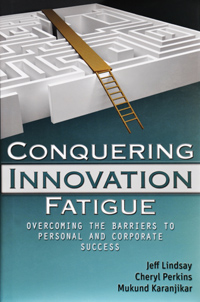Conquering Innovation Fatigue
 In a new book titled "Conquering Innovation Fatigue", authors Jeff Lindsay, Cheryl Perkins and Mukund Karanjikar draw upon decades of experience to offer guidance to leaders, employees, entrepreneurs and others seeking success through innovation. Here, the authors share an excerpt explaining the nine major innovation fatigue factors that can block your path to personal and corporate fulfillment.
In a new book titled "Conquering Innovation Fatigue", authors Jeff Lindsay, Cheryl Perkins and Mukund Karanjikar draw upon decades of experience to offer guidance to leaders, employees, entrepreneurs and others seeking success through innovation. Here, the authors share an excerpt explaining the nine major innovation fatigue factors that can block your path to personal and corporate fulfillment.
1. People Fatigue (Fatigue from the Way People Act)
"People fatigue" includes the personal flaws of individuals, including inventors and those they work with. Greed, for example, can result in theft from the inventor, while excessive demands from the inventor can also block progress. Arrogance or excessive pride from others can result in the "Not Invented Here" syndrome that can shut down opportunity, while the same flaws in the inventor can hinder the cooperation needed to work with allies... We assign fatigue factors to the people
2. Organization Level Fatigue (Strategy, Culture, Actions)
Many fatigue factors arise from strategies, policies, and cultures in an organization. We consider, for example, the impact of errant metrics or poor decision making in evaluating opportunities... At the strategic level, "open innovation fatigue" results in many missed opportunities. One of the most critical issues for corporations, though, is the tenuous thread that links the "will to share" of the creative employee to the intellectual asset engines of the corporation. When trust is breached or other discouragements befall prospective innovators, innovation engines can quickly shift into neutral. Factors that make innovators feel devalued are one part of this problem.
Beyond the fatigue factors that arise from individuals and organizations, a host of external factors can contribute to innovation fatigue. These environmental factors can include barriers to protecting and exploiting one's intellectual assets arising from patent systems, legislation, regulation, and other aspects of government policy. Also included are roadblocks to open innovation such as barriers to university-industry cooperation from legislation and tax policy.
Within the scope of these three classes of fatigue factors, we explore nine more specific fatigue factors:
1. Theft of the invention and exploitation of inventors
2. Innovator deficiencies (e.g., unreasonable expectations, impatience, unhealthy pride)
3. The "Not Invented Here" syndrome
Organization Level Fatigue:
4. Breaking the will to share (loss of cooperation from the innovation community)
5. Fundamental flaws in decision making and vision
6. Open innovation fatigue (corporate barriers to external innovation and collaboration)
External Fatigue:
7. Patent pain: barriers to intellectual property protection
8. Regulatory pain: challenges in policy, regulation and law
9. University-industry barriers
Similar themes occur in each of the three main categories of fatigue factors. Whether at the individual, organizational, or external level, factors can be grouped in terms of threats to intellectual property and trust, barriers to collaboration, and flaws in judgment and behavior (including corporate and governmental behaviors or policies).
